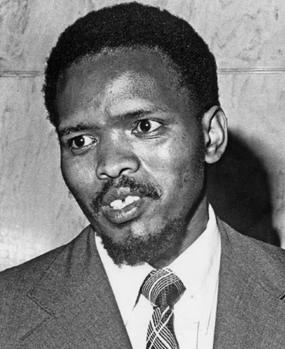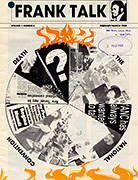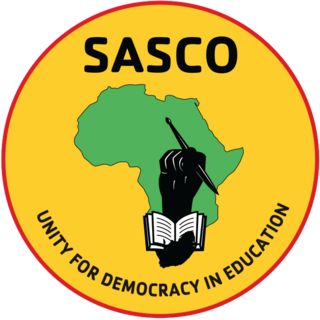
Bantu Stephen Biko was a South African anti-apartheid activist. Ideologically an African nationalist and African socialist, he was at the forefront of a grassroots anti-apartheid campaign known as the Black Consciousness Movement during the late 1960s and 1970s. His ideas were articulated in a series of articles published under the pseudonym Frank Talk.
The Black People's Convention (BPC) was a national coordinating body for the Black Consciousness movement of South Africa. Envisaged as a broad-based counterpart to the South African Students' Organisation, the BPC was active in organising resistance to apartheid from its establishment in 1972 until it was banned in late 1977.

The Azanian People's Organisation (AZAPO) is a South African liberation movement and political party. The organisation's two student wings are the Azanian Students' Movement (AZASM) for high school learners and the other being for university level students called the Azanian Students' Convention (AZASCO), its women's wing is Imbeleko Women's Organisation, simply known as IMBELEKO. Its inspiration is drawn from the Black Consciousness Movement inspired philosophy of Black Consciousness developed by Steve Biko, Harry Nengwekhulu, Abram Onkgopotse Tiro, Vuyelwa Mashalaba and others, as well as Marxist Scientific Socialism.
The Black Consciousness Movement (BCM) was a grassroots anti-Apartheid activist movement that emerged in South Africa in the mid-1960s out of the political vacuum created by the jailing and banning of the African National Congress and Pan Africanist Congress leadership after the Sharpeville Massacre in 1960. The BCM represented a social movement for political consciousness.
[Black Consciousness'] origins were deeply rooted in Christianity. In 1966, the Anglican Church under the incumbent, Archbishop Robert Selby Taylor, convened a meeting which later on led to the foundation of the University Christian Movement (UCM). This was to become the vehicle for Black Consciousness.

Nyameko Barney Pityana FKC GCOB is a human rights lawyer and theologian in South Africa. He is an exponent of Black theology.
The National Union of South African Students (NUSAS) was an important force for liberalism and later radicalism in South African student anti-apartheid politics. Its mottos included non-racialism and non-sexism.

Internal resistance to apartheid in South Africa originated from several independent sectors of South African society and took forms ranging from social movements and passive resistance to guerrilla warfare. Mass action against the ruling National Party (NP) government, coupled with South Africa's growing international isolation and economic sanctions, were instrumental in leading to negotiations to end apartheid, which began formally in 1990 and ended with South Africa's first multiracial elections under a universal franchise in 1994.

Frank Talk was a political magazine established in 1984 in South Africa, and arising out of the student-led anti-apartheid movement of the 1970s and 80s.
Neville Wilson Curtis was an anti-apartheid activist and leader of the National Union of South African Students.
Saleem Badat is a South African sociologist, higher education policy specialist, and researcher. He is Research Professor in Humanities at the University of Kwazulu-Natal.

The South African Students Congress (SASCO) is a South African student organisation currently led by Athenkosi Mabona as the organization's President. SASCO was founded in September 1991 at Rhodes University in Grahamstown, Eastern Cape, through the merger of the South African National Student Congress (SANSCO) and the National Union of South African Students (NUSAS). The predecessor of SANSCO, the Azanian Students Organisation (AZASO) was initially formed in 1979 as a continuation of the South African Students Organisation (SASO) when the latter was banned by the Apartheid government. SASO, in turn, got started by Steve Biko as a breakaway faction from NUSAS in the 1960s.
Mapetla Mohapi was a member of the Black Consciousness Movement, who died in detention during Apartheid in 1976.
Dr. Maitshwe Nchuape Aubrey Mokoape was a South African anti-apartheid activist and a leader of the Pan-Africanist Congress and Black Consciousness Movement. He was first arrested and detained at the age of 15. He studied and worked alongside political anti-apartheid activist Steve Biko. In post-apartheid South Africa, Mokoape became a physician.
Aelred Stubbs was an Anglican priest and monk, influential in the campaign against apartheid in South Africa during the 1970s.
The Azanian Students Organisation (AZASO) was a student movement in South Africa founded in 1979 as a replacement for the banned South African Student Organisation (SASO). It would become the South African National Students Congress (SANSCO) in 1986, after adopting the Educational Charter and aligning itself officially with the Freedom Charter. This was to be merged in 1991 with the National Union of South African Students to form the South African Students Congress.
Winnie Motlalepula Kgware was a South African anti-Apartheid activist within the Black Consciousness Movement (BCM). She was elected as the first president of the Black People's Convention (BPC), a BCM-affiliated community-based organisation in 1972.
The SASO/BPC trial, also known as the Black Consciousness trial, was an apartheid-era legal trial in South Africa which resulted in the conviction of nine Black Consciousness activists from the South African Students' Organisation (SASO) and Black People's Convention (BPC). The trial ran from 31 January 1975 to 21 December 1976 in the Pretoria Supreme Court.
Pandelani Jeremia Nefolovhodwe is a South African politician and former anti-apartheid activist who served as deputy president of the Azanian People's Organisation (AZAPO) from 1992 to 2010. He represented the party in the National Assembly from 2002 to 2009 and was formerly its president from 1990 to 1992.
Aubrey Dundubela Mokoena was a South African politician and former anti-apartheid activist. He represented the African National Congress (ANC) in the National Assembly from 1994 to 2014, excepting a brief hiatus in 2009. He served the Gauteng constituency and chaired the Portfolio Committee on Home Affairs from 1999 to 2002.
Daniel Ntjammu Habedi is a South African politician and former anti-apartheid activist. He is a former secretary-general of the Azanian People's Organisation and represented the party in the National Assembly from April to June 2004; his tenure was cut short by the Electoral Court's finding that the seat had been allocated to the wrong party.






